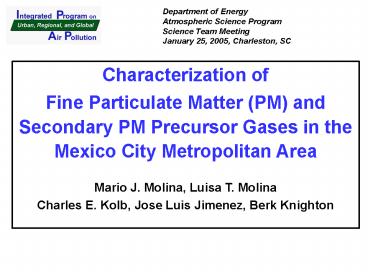Characterization of PowerPoint PPT Presentation
1 / 22
Title: Characterization of
1
Department of Energy Atmospheric Science Program
Science Team Meeting January 25, 2005,
Charleston, SC
Characterization of Fine Particulate Matter (PM)
and Secondary PM Precursor Gases in the Mexico
City Metropolitan Area Mario J. Molina, Luisa T.
Molina Charles E. Kolb, Jose Luis Jimenez, Berk
Knighton
2
Topographical map of theMexico City Metropolitan
Area (MCMA)
- Population Growth
- 18 million (2000) 20-fold increase since 1900
- Growth projection to gt25 million (2010)
- Urban Sprawl
- 1500 km2 (2000) 10-fold increase since 1960
- Expansion to peripheral areas
- Geographic and Topographical Conditions
- High altitude (2240m) less efficient combustion
processes - Mountains are a physical barrier for winds
- 2nd largest megacity in the world
- Temperature inversions in the dry season
- Increases in Emissions Sources
3
MCMA-2006 Field Measurement Campaign Project
Objectives
- Characterize the formation processes and
chemical content of fine PM and SOA
precursors - Provide critical ground truth data to
interpret the airborne data sets targeted
during the Field Campaign - Adequate ground-based source data will
facilitate understanding variations in the
airborne data of the MCMA atmosphere and
outflow plume.
4
MCMA-2006 Field Measurement Campaign Project Plan
- YEAR 1
- Analyze MCMA-2003 PM and PM precursor data
- Define scientific questions and set measurement
strategies for 2006 campaign - Develop measurement plan together with Mexican
and DOE/NCAR scientific collaborators - YEAR 2
- Plan and prepare logistics/instruments and deploy
to MCMA - Execute measurement plan in coordination with
other research groups. - YEAR 3
- Initial analysis of 2006 data
- Evaluate data using photochemical/transport
models.
5
MCMA-2006 Field Measurement Campaign Science
Questions
1. Spatial and temporal distributions and
chemical characteristics of primary fine PM
emissions - Particle properties and source
strengths of major mobile PM sources -
Identify and characterize major non-mobile PM
sources, including food vendor cooking,
refuse fires and industrial sources 2. SOA
precursor emissions and formation rates - NOx
, HONO, NH3, VOCs, SO2 - Joint analysis of gas
and aerosol species - Boundary layer
distribution with LIDAR 3. Photochemical and
meteorological information to evaluate
different PM and SOA precursor emission
inventories - Inverse modeling of ambient PM
and PM precursor species - Use back
trajectories to estimate emissions from
measurements
6
MCMA-2006 Field Measurement Campaign Science
Questions (cont)
4. Evaluate accuracy of current photochemical
and aerosol microphysics models in predicting
MCMA fine PM burdens, chemical
concentrations, and spatial distributions -
Sensitivity of the models to PM emissions, PM
precursor emissions, meteorology, dry
deposition, wet deposition, radiative
properties, precursor photochemistry, and aerosol
microphysics and dynamics - Impact of the
daily planetary boundary layer cycle on PM and
PM precursor concentrations - Influence of
variations in daily MCMA fine PM and PM precursor
burdens on subsequent outflows and downwind
PM loadings - Evolution of the chemical and
physical properties of the fine PM as the
particles age
7
MCMA-2006 Field Measurement Campaign Project
Deliverables
- Yr 1 Archived/QAed data and selected analysis
results from MCMA-2003 (e.g., an
improved NOx and VOC emissions inventory). - Yr 2 An MCMA logistics plan and a ground based
field measurement plan that covers the 3
groups plus Mexican collaborators. - Yr 3 Archived QAed 2006 data plus selected
analysis results.
8
Summary of MCMA-2003 Field Measurement Campaign
- Exploratory mission (February 2002)
- Intensive 5-week field measurement (Spring 2003)
- Special Session on Megacity Impacts on Air
Quality at the Fall 2004 AGU Meeting - Special Issue of the MCMA 2003 Campaign in ACP
(Atmospheric Chemistry and Physics) - NARSTO sanctioned field campaign data will be
posted on NARSTO website - Photochemical/Transport Modeling in progress
(CIT, MM5, CAMx, etc.)
9
Boundary Sites and Surface Meteorological
Stations for the MCMA-2003 Campaign
NOTE The SMN network located in México City,
Hidalgo, State of Mexico and Morelos and RAMA
Stations are not included in this map..
10
Aerial View of CENICA Supersite MCMA 2003
Flux Tower
Monitoring and Sampling Station
HUT (AMS, DOAS, FTIR, PTR-MS)
LIDAR
ARI Van
Tethered balloon
11
CENICA Supersite Measurements during MCMA-2003
Direct VOC Flux Measurements
- DOE/Argonne National Lab
- (Jeff Gaffney, Nancy Marley)
- - PAN, black carbon, olefins, NH3
- DOE/ PNNL (Tom Jobson, Michael Alexander, John
Hubbe, Steve Cowan, Alex Laskin, Jim Barnard, and
others. ) - - PTRMS, MFRSBR, RSR
- single particle sampler/analyzer
- UCR (Janet Arey, Roger Atkinson)
- - PAHs, nitro-PAHs,
12
MCMA-2003 Field Campaign Supersite (CENICA)
Instrumentation
- Instrumentation
- CENICA - monitoring station, tethered balloon
- RAMA - monitoring station
- WSU VOC sampling
- DOE/ PNNL PTRMS, single particle
sampler/analyzer, MFRSBR, RSR - UCB/LBL Particle sampling apparatus
- DOE/Argonne National Lab PAN, black carbon,
olefins, NH3 - Colorado U. AMS
- Penn State OH and HO2
- IMP MINIVOLS and MOUDI, aldehyde cartridges
- MIT/U. Heidelberg - DOAS
- MIT/ Free U. Berlin LIDAR
- MIT PAHs
- UCR nitro-PAHs, PAHs
- EPFL - LIDAR
- UNAM FTIR
- Chalmers FTIR, DOAS
- Plus others
13
MCMA HO2 levels are much greater than NYCs
- MCMAs high HO2 indicates that ozone production,
P(O3), will be large.
14
MCMA 2003 Glyoxal and SOA precursors
Glyoxal
Aromatic VOCs
SOA Precursors
SOA
First time DOAS detection of Glyoxal in the
atmosphere
CENICA
East South South-West
15
(No Transcript)
16
Mobile Laboratory Modes of Operation February
2002 April 2003
Stationary Sampling High time resolution point
sampling Quality Assurance for conventional air
monitoring sites
Mobile Sampling/Mapping Motor vehicle pollution
emission ratios Large source plume
identification Ambient background pollution
distributions
Chase Detailed mobile source emissions
characterization Plume tracer flux measurements
17
In-plume Sampling indicated by above-ambient
CO2 levels
Emission perturbed level
DCO2
Ambient background level
18
Aerosol measurements (April 15-17, 2003)
19
PM2.5 Concentration
20
Heterogeneity in a single soot particle
S, K inclusions
Only Carbon
S inclusion
Si inclusion
(Source MIT/PNNL)
21
Processing of Soot
From Chase Studies
In Ambient Air
PIXE Spectra
22
Classification of MCMA-2003 Meteorological Events
GOES-12
Basin Schematic

